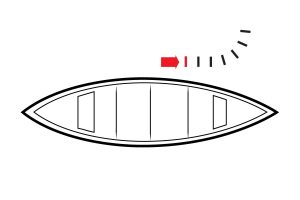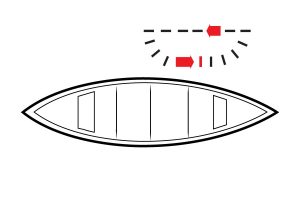J-Stroke Basics (Stern)
The canoe J-Stroke is probably the most important canoe stroke to learn yet most recreational canoeists don’t even know it exists. Every person who has ever sat in a canoe knows how difficult it is to keep it going straight. The reason for this is that with every stroke of the paddle, the canoe wants to turn to the opposite side. The canoe J-stroke is the remedy to this problem and actually allows the canoeist to correct the direction of the canoe while paddling forward. This is a steering stroke used extensively by the stern paddler in tandem canoeing.

To perform this stroke, be sure that you are holding the canoe paddle properly and that you are sitting up straight.
- The J-stroke begins with the forward stroke and then the correction phase.
- When your shaft hand reaches the point between your knees and hip, twist the power face of the blade away from the canoe and out.
- Rotate the grip hand so that the thumb moves forward and down.
- Keep a fairly loose grip with the shaft hand on your paddle to allow the shaft to rotate.
- This movement will allow you to “pry” (push out) the blade out off the canoe’s gunwale, like a “J” and correct the direction of the canoe. (The Pry Stroke will be discussed in another post)
- Slice the blade out of the water and carry it flat (parallel) over the water and forward to begin the stroke again.
Tips:
- J-stroke can be used as often as necessary, depending on the winds and currents, to keep the canoe moving in a straight line.
- The more accustomed you become to this stroke, the more you’ll know how much to push out at the end.
- The bow person (front of the canoe) should paddle on the opposite side from the stern person and should use the forward stroke. Both bow and stern persons should paddle in unison and use the same power of strokes to be most efficient.
Canadian J- Stroke
This stroke is similar to the J-stroke only the paddle stays in the water.

- Starts off the same as the J-stroke, but rather than pulling the blade out of the water at the end, the blade is “knifed” forward under the water. Then you are ready for the next power stroke without taking the blade out of the water.
- If done carefully, there is no sound from the paddle, making it possible to paddle in calm water without sound. This version of the J-stroke is more relaxing & doesn’t make you as tired on longer trips.
Both strokes are demonstrated in the following video by Kevin Callan:
Credits:
George Sayour- Author (article) January 3, 2018
Canoe Paddle Strokes – Wikipedia
The Canadian Stroke – Kevin Callan
Photo: By MooseHead88 – Own work, CC BY-SA 3.0
Paddle Canada – Canoe Strokes Resource Document
How to Paddle a Canoe: Strokes and Techniques – Erich Volkstorf
